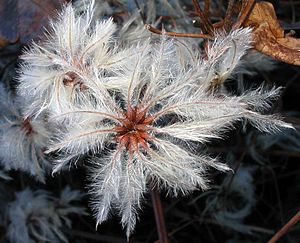ἀθραγένη
English (LSJ)
ἡ, smoke-wood, Clematis vitalba, old man's beard, traveller's joy Thphr.HP5.9.6.
German (Pape)
[Seite 47] ἡ, eine Pflanze, Theophr.
Spanish (DGE)
-ης, ἡ
bot. clemátide, vidarra, Clematis vitalba L., Thphr.HP 5.9.6, Ign.64.
• Etimología: Varias hipótesis, todas inseguras. Para unos rel. c. θραγμός, q.u.; para otros es ide. pregriego.
Greek (Liddell-Scott)
ἀθραγένη: ἡ, εἶδος δένδρου ἐξ οὗ ἐλαμβάνετο προσάναμμα, (ἴσκα), Θεοφρ. Ι. Φ. 5. 9, 6.
Frisk Etymological English
Grammatical information: f.
Meaning: a plant, Clematis vitalba (Thphr.).
Origin: PG [a word of Pre-Greek origin]
Etymology: Frisk compares ἄθρας, which would fit "zu einem Schlinggewächs", but I don't see what a car has to do with it. See Strömberg Pflanzennamen 108. Fur. 288 compares ἀνδράχνη and concludes to substr. origin (prenasalization), which is anyhow prob.
Frisk Etymology German
ἀθραγένη: {athragénē}
Meaning: Pflanzenname, Clematis vitalba (Thphr.).
Etymology: Morphologisch ganz dunkel. Das Vorderelement ἀθρα- erinnert an das folgende Wort und würde zu einem Schlinggewächs nicht schlecht passen. Andere Deutungsversuche bei Strömberg Pflanzennamen 108.
Page 1,28
Wikipedia EN
Clematis vitalba (also known as old man's beard and traveller's joy) is a shrub of the family Ranunculaceae. Clematis vitalba is a climbing shrub with branched, grooved stems, deciduous leaves, and scented greeny-white flowers with fluffy underlying sepals. The many fruits formed in each inflorescence have long silky appendages which, seen together, give the characteristic appearance of old man's beard. The grooves along the stems of C. vitalba can easily be felt when handling the plant.
This species is eaten by the larvae of a wide range of moths. This includes many species which are reliant on it as their sole foodplant; including small emerald, small waved umber and Haworth's pug.
Translations
ab: алмышәӡахәа; ar: ظيان أبيض; az: üzümyarpaq ağəsmə; bar: lüln; bg: обикновен повет; ca: vidalba; co: vittichju; cs: plamének plotní; cy: barf hen ŵr; da: almindelig skovranke; de: Gewöhnliche waldrebe; et: harilik elulõng; eu: aihenzuri; fa: کلماتیس سفید; fi: saksankärhö; ga: gabhrán; hr: obična pavitina; hsb: lěsny pryšćenc; hu: erdei iszalag; hy: մամրիչ խաղողատերև; li: rieraank; lt: gelsvoji raganė; lv: vīnlapu mežvītenis; mk: павит; nds_nl: wilde ranker; nl: bosrank; pl: powojnik pnący; ru: ломонос виноградолистный; simsq: kulpra; sr: павит; sv: skogsklematis; uk: ломиніс виткий; vec: vixon; wa: rampioûle ordinaire

